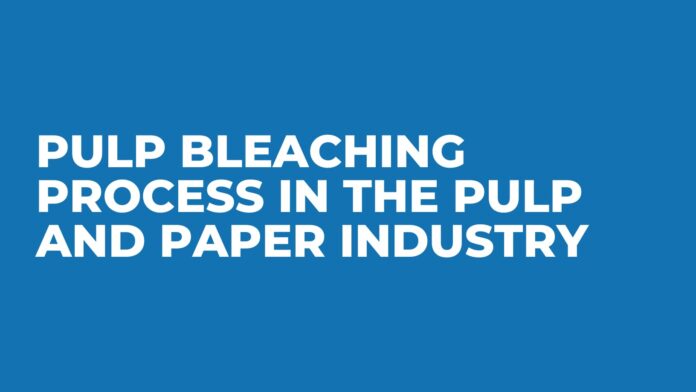Introduction
The pulp bleaching process is an important step in the pulp and paper industry. It helps to enhance the brightness and the quality of the paper product. It removes residual lignin and other impurities from the pulp, resulting in a cleaner and whiter final product.
As the demand for high-quality paper and sustainable practices is growing, modern pulp bleaching techniques have evolved to fulfill this need. These new techniques are more environmentally friendly while maintaining efficiency.
In this blog, we will explore the pulp bleaching process, its significance, various bleaching methods, and its impact on the industry.
What is the Pulp Bleaching Process?
The pulp bleaching process is a chemical treatment that aims to increase the brightness of pulp by removing or altering the color-causing components. The primary color-causing component in the pulp is lignin. It is an essential step in the production of high-grade paper specially used for printing, writing, and packaging.
The pulp bleaching process involves various stages where it needs to utilize different chemical agents and technologies to achieve the desired brightness and quality while minimizing environmental impact.
Why is Pulp Bleaching Done?
The primary reasons for bleaching pulp include:
- Enhanced Brightness and Whiteness: Increases the aesthetic appeal and readability of paper.
- Improved Paper Quality: Reduces the presence of impurities that may affect the strength and texture of paper.
- Suitability for Printing and Writing: The bright paper provides better contrast for printing and ensures better ink adhesion.
- Compliance with Industry Standards: Many industries require specific brightness levels for different paper products.
- Reduction of Environmental Impact: Modern bleaching processes aim to reduce harmful byproducts and ensure sustainability.
How is Pulp Bleaching Done?
The pulp bleaching process involves various stages, each designed to eliminate residual lignin and other unwanted substances. It typically follows these steps:
1. Initial Pulping and Washing
Before bleaching, the pulp is extracted using mechanical or chemical pulping methods. It is then washed to remove any loose fibers and dissolved organic matter.
2. Chemical Treatment Stages
Bleaching is carried out in multiple stages, with different chemicals used in each stage to break down and remove lignin. The most common chemicals used include:
- Chlorine-Based Bleaching
- Elemental Chlorine-Free (ECF) Bleaching
- Totally Chlorine-Free (TCF) Bleaching
3. Multiple Bleaching Sequences
The bleaching process is not a single-step operation but involves a sequence of chemical treatments:
- Delignification Stage: Uses oxygen, ozone, or chlorine dioxide to break down lignin.
- Brightening Stage: Further treatment with hydrogen peroxide or chlorine dioxide to achieve the desired brightness.
- Final Washing and Neutralization: Ensures the removal of residual chemicals and stabilizes the pulp.
Types of Pulp Bleaching Process
The following are the types used for pulp bleaching in the paper production process:
1. Chlorine-Based Bleaching (Traditional Method)
- Uses chlorine gas or hypochlorite.
- Produces high brightness but generates toxic chlorinated compounds.
2. Elemental Chlorine-Free (ECF) Bleaching
- Uses chlorine dioxide instead of elemental chlorine.
- Significantly reduces environmental impact.
3. Totally Chlorine-Free (TCF) Bleaching
- Uses ozone, hydrogen peroxide, and oxygen.
- The most environmentally friendly method.
4. Oxygen-Based Bleaching
- Uses oxygen de-lignification before bleaching.
- Reduces the need for harmful chemicals.
Environmental Impact of Pulp Bleaching
Traditional bleaching processes have been associated with pollution due to the release of chlorinated organic compounds into water bodies. However, modern advancements such as ECF and TCF bleaching have significantly reduced the environmental footprint of the paper industry. Sustainable practices, recycling efforts, and closed-loop water treatment systems further contribute to minimizing the ecological impact.
The pulp bleaching process is an important part of the paper manufacturing industry. You can contact us for any updates, paper mill audits, paper manufacturing machinery needs, and other pulp and paper industry-related requirements.
Conclusion
Pulp bleaching is an essential process in the paper industry, ensuring high-quality, bright paper products while meeting environmental regulations. With the shift towards sustainable bleaching techniques such as ECF and TCF, the industry is moving towards a greener future. By embracing innovative and eco-friendly methods, paper manufacturers can continue to meet the demand for high-quality paper while reducing their environmental impact.
By understanding the pulp bleaching process and its advancements, businesses and consumers alike can make informed choices that support sustainability in the pulp and paper industry.

